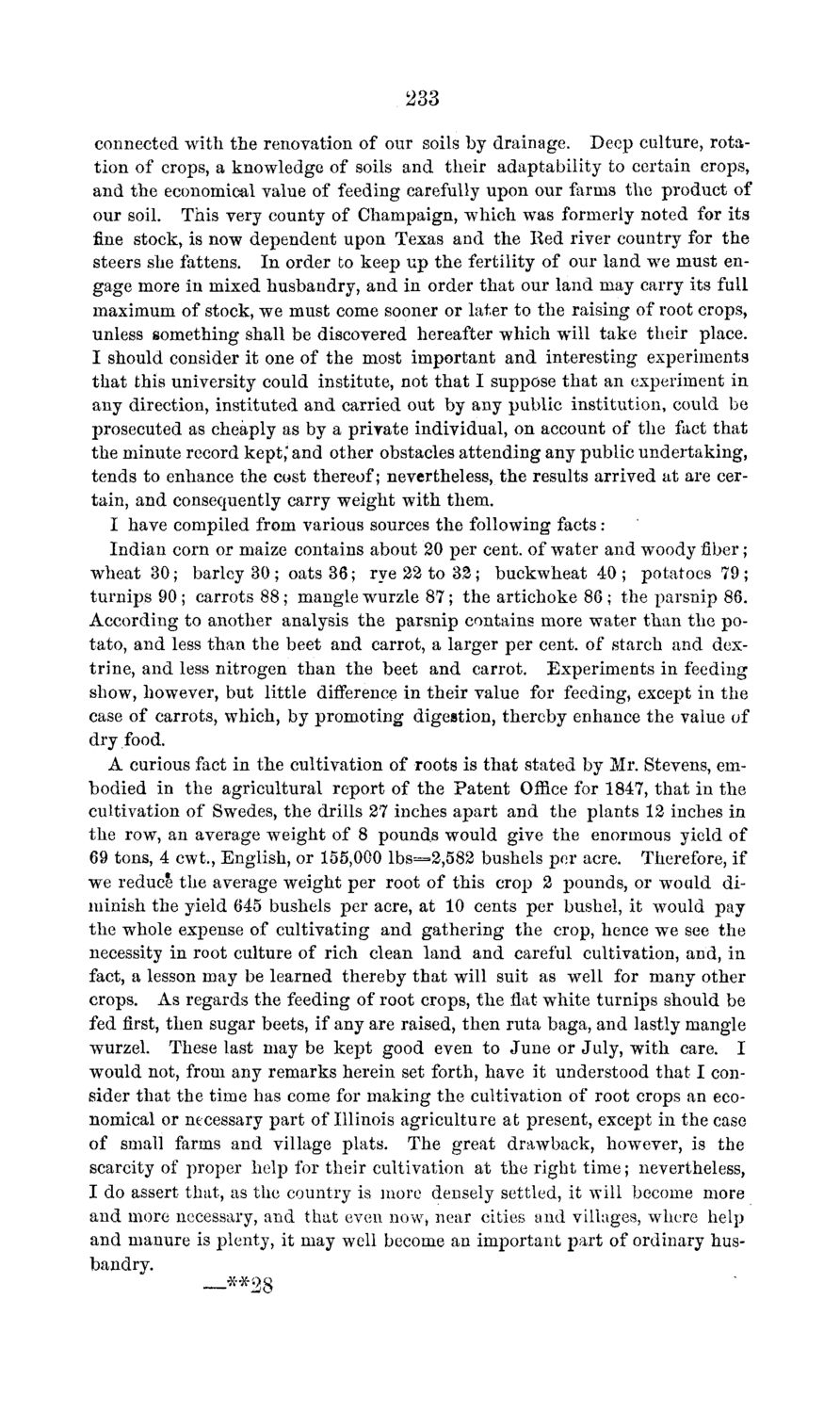| |
| |
Caption: Board of Trustees Minutes - 1869
This is a reduced-resolution page image for fast online browsing.

EXTRACTED TEXT FROM PAGE:
233 connected writh the renovation of our soils by drainage. Deep culture, rotation of crops, a knowledge of soils and their adaptability to certain crops, and the economical value of feeding carefully upon our farms the product of our soil. This very county of Champaign, which was formerly noted for its fine stock, is now dependent upon Texas and the Red river country for the steers she fattens. In order to keep up the fertility of our land we must engage more in mixed husbandry, and in order that our land may carry its full maximum of stock, we must come sooner or later to the raising of root crops, unless something shall be discovered hereafter which will take their place. I should consider it one of the most important and interesting experiments that this university could institute, not that I suppose t h a t an experiment in any direction, instituted and carried out by any public institution, could be prosecuted as cheaply as by a private individual, on account of the fact that the minute record kept; and other obstacles attending any public undertaking, tends to enhance the cost thereof; nevertheless, the results arrived at are certain, and consequently carry weight with them. I have compiled from various sources the following facts : Indian corn or maize contains about 20 per cent, of water and woody fiber; wheat 30; barley 3 0 ; oats 36; rye 22 to 3 2 ; buckwheat 4 0 ; potatoes 7 9 ; turnips 90 ; carrots 88 ; mangle wurzle 87 ; the artichoke 86 ; the parsnip 86. According to another analysis the parsnip contains more water than the potato, and less than the beet and carrot, a larger per cent, of starch and dextrine, and less nitrogen than the beet and carrot. Experiments in feeding show, however, but little difference in their value for feeding, except in the case of carrots, which, by promoting digestion, thereby enhance the value of dry food. A curious fact in the cultivation of roots is that stated by Mr. Stevens, embodied in the agricultural report of the Patent Office for 1847, t h a t in the cultivation of Swedes, the drills 27 inches apart and the plants 12 inches in the row, an average weight of 8 pounds would give the enormous yield of 69 tons, 4 cwt., English, or 155,000 lbs=2,582 bushels per acre. Therefore, if we reduce the average weight per root of this crop 2 pounds, or would diminish the yield 645 bushels per acre, at 10 cents per bushel, it would pay the whole expense of cultivating and gathering the crop, hence we see the necessity in root culture of rich clean land and careful cultivation, and, in fact, a lesson may be learned thereby that will suit as well for many other crops. As regards the feeding of root crops, the flat white turnips should be fed first, then sugar beets, if any are raised, then ruta baga, and lastly mangle wurzel. These last may be kept good even to June or July, with care. I would not, from any remarks herein set forth, have it understood that I consider that the time has come for making the cultivation of root crops an economical or necessary part of Illinois agriculture at present, except in the case of small farms and village plats. The great drawback, however, is the scarcity of proper help for their cultivation at the right t i m e ; nevertheless, I do assert that, as the country is more densely settled, it will become more and more necessary, and that even now, near cities and villages, where help and manure is plenty, it may well become an important part of ordinary husbandry. _ *#28
| |